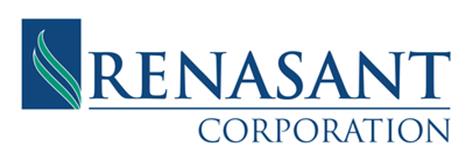ABOUT RENASANT CORPORATION:
Renasant Corporation is the parent of Renasant Bank, a 117-year-old financial services institution. Renasant has assets of approximately $16.2 billion and operates 200 banking, lending, mortgage, wealth management and insurance offices in Mississippi, Tennessee, Alabama, Florida, Georgia, North Carolina and South Carolina.
CAUTIONARY NOTE REGARDING FORWARD-LOOKING STATEMENTS:
This press release may contain, or incorporate by reference, statements about Renasant Corporation that constitute “forward-looking statements” within the meaning of Section 27A of the Securities Act of 1933, as amended, and Section 21E of the Securities Exchange Act of 1934, as amended. Statements preceded by, followed by or that otherwise include the words “believes,” “expects,” “projects,” “anticipates,” “intends,” “estimates,” “plans,” “potential,” “possible,” “may increase,” “may fluctuate,” “will likely result,” and similar expressions, or future or conditional verbs such as “will,” “should,” “would” and “could,” are generally forward-looking in nature and not historical facts. Forward-looking statements include information about the Company’s future financial performance, business strategy, projected plans and objectives and are based on the current beliefs and expectations of management. The Company’s management believes these forward-looking statements are reasonable, but they are all inherently subject to significant business, economic and competitive risks and uncertainties, many of which are beyond the Company’s control. In addition, these forward-looking statements are subject to assumptions with respect to future business strategies and decisions that are subject to change. Actual results may differ from those indicated or implied in the forward-looking statements, and such differences may be material. Prospective investors are cautioned that any forward-looking statements are not guarantees of future performance and involve risks and uncertainties and, accordingly, investors should not place undue reliance on these forward-looking statements, which speak only as of the date they are made.
Important factors currently known to management that could cause our actual results to differ materially from those in forward-looking statements include the following: (i) the continued impact of the COVID-19 pandemic (and variants thereof) and related governmental response measures on the U.S. economy and the economies of the markets in which we operate; (ii) the Company’s ability to efficiently integrate acquisitions into its operations, retain the customers of these businesses, grow the acquired operations and realize the cost savings expected from an acquisition to the extent and in the timeframe anticipated by management; (iii) the effect of economic conditions and interest rates on a national, regional or international basis; (iv) timing and success of the implementation of changes in operations to achieve enhanced earnings or effect cost savings; (v) competitive pressures in the consumer finance, commercial finance, insurance, financial services, asset management, retail banking, mortgage lending and auto lending industries; (vi) the financial resources of, and products available from, competitors; (vii) changes in laws and regulations as well as changes in accounting standards; (viii) changes in policy by regulatory agencies; (ix) changes in the securities and foreign exchange markets; (x) the Company’s potential growth, including its entrance or expansion into new markets, and the need for sufficient capital to support that growth; (xi) changes in the quality or composition of the Company’s loan or investment portfolios, including adverse developments in borrower industries or in the repayment ability of individual borrowers; (xii) an insufficient allowance for credit losses as a result of inaccurate assumptions; (xiii) general economic, market or business conditions, including the impact of inflation; (xiv) changes in demand for loan products and financial services; (xv) concentration of credit exposure; (xvi) changes or the lack of changes in interest rates, yield curves and interest rate spread relationships; (xvii) increased cybersecurity risk, including potential network breaches, business disruptions or financial losses; (xviii) civil unrest, natural disasters, epidemics and other catastrophic events in the Company’s geographic area; (xix) the impact, extent and timing of technological changes; and (xx) other circumstances, many of which are beyond management’s control.
